
Laser Car Ignition Dream Sparks Multiple Approaches
Laser car ignition systems promise better fuel efficiency and lower pollution than conventional ones – as long as the technology continues to develop.
As calls for improved energy efficiency and reduced auto emissions grow ever louder, lasers are being investigated as possible replacements for the conventional spark plug. But there’s another reason, too.
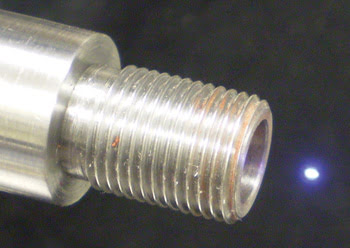
Laser car ignition technology could lead to improved energy efficiency and reduced auto emissions. Here, a laser spark is emitted at the end of the National Energy Technology Laboratory laser spark plug.
“Every laser jock wants to run an engine with laser ignition,” said Dr. Steven D. Woodruff, a research chemist at the US Department of Energy’s National Energy Technology Laboratory (NETL) in Morgantown, W.Va. “I became involved with a team working on new ignition systems for natural gas reciprocating engines, and this was a natural fit.”
Woodruff’s focus at NETL is on laser spectroscopic diagnostics in combustion, and his current projects include developing a laser spark plug for natural gas-fueled engines. He also serves as an adjunct professor in the Mechanical and Aerospace Engineering Department at West Virginia University, also in Morgantown.
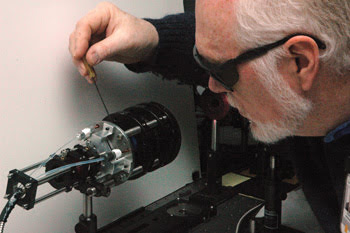
Dr. Steven D. Woodruff makes lab-bench adjustments on the National Energy Technology Laboratory (NETL) prototype laser spark plug. The team has lab-tested its laser ignition system on a single-cylinder engine.
His colleague Dr. Dustin L. McIntyre wrote his 2007 doctoral dissertation on a laser spark plug ignition system for stationary lean-burn natural gas engines. McIntyre continues to develop intellectual property related to lasers, laser diagnostics and laser ignition systems, and has more than 10 years of experience in ignition-system and high-energy-laser design.
“As a graduate student, I developed an interest in novel ignition systems and worked to develop a microwave plasma ignition system for my master’s degree,” McIntyre said. “When the opportunity became available for me to study laser ignition for my continued graduate work, I felt that it aligned perfectly with my interests and prior experience.
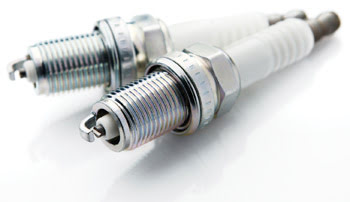
Conventional spark plugs such as these could someday be replaced by laser-based ignition systems, thanks to ongoing research.
“There was also the whole coolness factor, but, primarily, I was interested in moving a helpful and needed technology to market, where it could do some good in improving efficiencies and reducing exhaust emissions.”
Feeling the lean burn
Lean-burn operation is vital for low NOx emissions in natural-gas-fueled engines, Woodruff noted. “Lean burn” means that the air-fuel ratio in an engine is high, so the engine is using less fuel.
“However, lean burn means less fuel in the cylinder unless you increase the compression ratio,” Woodruff added. “Increasing the compression ratio means high pressure, and standard spark plugs then need much more energy to spark. But laser plugs can do with less. Because more current passes through standard spark plugs, the electrodes wear more quickly, requiring early replacement at over $100 each.
“Laser plugs have no electrodes. Assuming replacement every 500 hours, this is $16,000 per year just in spark plug costs, compared to approximately $10,000 for the laser diode array. The usual advertised lifetime for laser diodes is over 10,000 hours, and, since the duty factor is 10 to 20 percent, they can potentially last for much longer.”
Removing the electrodes from the system has a big impact. “The impetus behind the work was spark plug erosion, emissions reduction through lean-burn operation and efficiency improvement in large-bore stationary natural gas engines used for pipeline pumping and distributed electrical power generation,” McIntyre said. “A laser ignition system allows for the spark plug electrodes to be completely removed from the combustion chamber, and it optically produces a larger spark kernel within the fuel/air mixture to initiate combustion.”
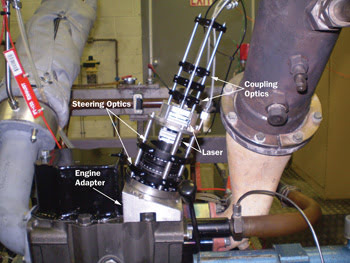
The NETL prototype laser spark plug is mounted onto a research engine fueled by natural gas or a natural gas/hydrogen mixture. The laser is pumped via optical fiber by a 225-µs pulse from a 200-W diode laser at 810 nm, resulting in a 10 mJ, 2.5-ns Q-switched pulse with 1-µs jitter.
The engine as a whole also can work at a higher pressure level with laser ignition. “This has two primary advantages,” McIntyre said. “The increase in the operating pressure improves the thermal efficiency by reducing the pumping losses of the engine, and, secondly, according to Paschen’s law, as gas pressure increases, the voltage potential required to initiate a breakdown between two electrodes increases significantly.
“In other words, more and more insulators – air and fuel molecules – are being crammed between the electrodes, making an electrical discharge more difficult. As the pressure increases, the voltage and the spark energy must also increase dramatically, which shortens the spark plug lifetime because the electrodes are basically being eroded away one spark at a time.”
A spark plug’s electrodes also “steal” a good deal of energy from the ignition spark, McIntyre added, which means that the spark must achieve much higher energy just to maintain normal combustion. “For a laser spark discharge, the optical breakdown threshold falls dramatically as the pressure increases because more optical absorbers – air and fuel molecules – are being crammed into the focal volume,” he said. “Therefore, laser ignition becomes much easier as the pressure is increased.”
Laser spark plugs in action
The high laser power needed to create a laser spark has been a challenge for laser distribution through optical fibers, which would be damaged by such high power, but NETL’s laser spark plug met that challenge by locating a compact Q-switched laser at the engine cylinder; this is pumped by a diode laser from one end through an optical fiber. This setup allows the laser power to be low enough that it does not damage fiber.
“Our system delivers low peak power – less than 1 kW – to a miniature passively Q-switched laser that it converts to a high peak power output of a few megawatts suitable to be focused down to approximately 100 GW/cm2 to create a laser spark,” McIntyre said.
This pump energy excites the laser, and the output that results is released in a high-peak-power pulse with a width of 2 to 3 ns. “The high-peak-power pulse is then directed into the combustion chamber so that the focal intensity exceeds the breakdown threshold of the fuel/air mixture,” McIntyre said.
The team has lab-tested its end-pumped laser spark plug system on a single-cylinder engine fueled by natural gas and also by natural gas with 20 percent hydrogen by volume. Over three days, the engine ran smoothly through various conditions as well as multiple shutdowns and startups.
“Our laser spark plug is a passively Q-switched Nd:YAG laser, 1 in. long, pumped coaxially by a diode laser source through a fiber optic,” Woodruff said. “The laser pulse is aimed through a thick fused-silica lens that also serves as the pressure barrier. With diode laser pumping, the energy cost is very similar to an electric spark system.”
“We currently hold a patent on the optical delivery system, which could be used to reach multiple cylinders on an engine with the proper timing,” McIntyre added.
Multiple approaches
The NETL team collaborated with an industry-academic consortium from 2002 to 2008, McIntyre said, to produce data that would validate the idea of laser ignition as an appropriate avenue. Each collaborator also developed its own intellectual property over those years, he noted.
“Others have investigated using a high-peak-output laser to simply deliver the high-peak-power pulse through an optical fiber or other type of waveguide,” McIntyre said. “Some have considered actuated mirrors that swing in and out of the laser path to redirect it to different locations.
“In the early development phase, most people in the consortium were using laboratory-scale high-peak-power lasers that were either directly connected to a single cylinder, or they were bouncing the laser beam across the room and into the combustion chamber.” This was carried out, he noted, mainly to obtain reliable data as other methods were being developed or considered.
“A Japanese group is working on ceramic Nd:YAG lasers, which may help lower the cost of the YAG component,” Woodruff said, “although the real high-cost component is the diode pump laser.”
He’s talking about the work of Dr. Takunori Taira and colleagues. Taira is an associate professor at the National Institutes of Natural Sciences, Institute for Molecular Science, and at the Department of Functional Molecular Science, The Graduate University for Advanced Studies (Sokendai), both in Okazaki, Japan. He also is an invited professor at Toyohashi University of Technology.
“Laser ignition allows us the ideal combustion,” Taira said. “As you know, the energy density of oil is two orders higher than [that of a] Li-ion battery. However, the conventional combustion is no longer the ideal situation. It requires [intense] ignition.”
Laser ignition was demonstrated back in 1974, he pointed out. “However, it was just basic research because the giant pulse lasers were so large, and [had such] poor efficiency and reliability for a long time.”
To make small, powerful lasers that could focus light to ~100 GW/cm2 with short pulses of more than 10 mJ each, Taira and colleagues at the National Institutes of Natural Sciences produced composite lasers from ceramic powders, heating them to fuse them into optically transparent solids. They also embedded metal ions in the lasers for tunability. Ceramics tune optically more easily than conventional crystals and are stronger, more durable and more thermally conductive, so that they can dissipate an engine’s heat without breaking down.
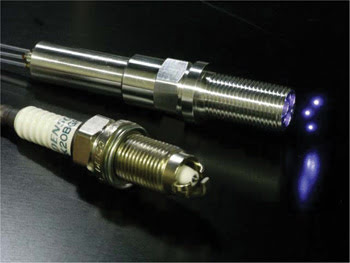
Researchers at the National Institutes of Natural Sciences have made composite lasers for car ignition systems from ceramic powders, heating them to fuse into optically transparent solids.
Their laser, which they presented at CLEO 2011, is built from two yttrium aluminum gallium segments, one doped with chromium, the other with neodymium; the resulting laser is powerful despite its small size at only 11 mm long and 9 mm in diameter. It can produce two laser beams, which the researchers say can ignite engine fuel in two places at once, making a flame wall that grows more uniformly and quickly than one created by a lone beam.
This setup cannot yet ignite the leanest available fuel mixtures with only a single pulse, but it can ignite a lean fuel mixture completely using several 800-ps-long pulses.
Spark plugs of the future
The technology may be in development today, but several challenges must be overcome before laser spark plugs appear on commercially available vehicles. Taira’s research is supported in part by Denso Co. of Aichi, Japan, and he believes strongly that laser spark plugs will go commercial in the coming years. The field is so promising, he said, that he will chair the first Laser Ignition Conference in April 2013 (see sidebar for more details).
Woodruff and McIntyre reported no current serious interest in their work from automakers but said that the technology could appear someday on consumer cars. At present, McIntyre pointed out, “the technology only offers lean-burn operation advantages for gasoline powered engines. The cost of the current technology would greatly offset any gains in emissions or fuel efficiency.”
That cost-benefit ratio is possibly the biggest hurdle that laser ignition will have to overcome. “It is difficult to compete with a $4 spark plug that will last 100,000 miles,” Woodruff said. “Current automobile engines run on liquid fuels at stoichiometric fuel air ratios and do not require the very high compression ratios.”
And cars might not even be the initial target for laser spark plugs.
“The most likely place for laser ignition to be employed in commercial applications would be natural gas-fueled transit buses,” McIntyre said. “Stationary natural gas engines will probably be the first market to adopt any commercial embodiment of laser ignition, and this will probably be encouraged by regulations.
“Currently, the automotive market is able to meet their emissions and efficiency goals with stoichiometric combustion in conjunction with exhaust after-treatment. If automakers begin looking at lean combustion in a serious manner, then laser ignition may be an option for designers.”
There are technologies that need to be proved before laser spark plugs can realistically be adopted, Woodruff said. “First, the diode laser pump must demonstrate that it can operate continuously for 10,000 hours,” he said. “Second, will the pressure barrier window/lens stay clean for 10,000 hours? The window is self-cleaning to some extent, in that each laser pulse cleans the window. If it holds up over the duration, it will then be competitive with electric spark for natural gas-fueled engines.”
Laser safety interlock systems are another must, McIntyre said. “The laser output can pose a serious eye safety hazard,” he noted. “Installed, the output is completely shielded and contained by the engine system.
“However, one concern is that an end user who is unfamiliar with high-peak-power lasers may tamper with a laser spark plug during operation. If the output were to strike someone in the eye, the eye would focus the high-peak-power pulse onto the retina, where it would cause irreparable damage. The person would most likely lose a considerable portion – if not all – of the vision in that eye. Therefore, work is being done to develop appropriate interlock systems that would disable one or more lasers if they were removed from their proper place of operation.”
There is still a spark of hope in the researchers’ eyes, and both continue to work on related research. “Our primary experimental work ended about four years ago, but I have continued to develop intellectual property as new technologies and new interests emerge,” McIntyre said. “Recently, I’ve been working with industry and academia to secure funding for further development and testing of an ignition system.”
Meet the author
Laura S. Marshall is managing editor of Photonics Spectra; email: [email protected]
Call for papers
The first Laser Ignition Conference will be collocated with the Optics & Photonics International Congress taking place from April 23-25, 2013, in Yokohama, Japan, and is intended to be a forum for discussion on all aspects of laser-induced ignition. The scope will include high-brightness lasers for ignition and diagnostics; laser-ignited engines for power generation and vehicles; and applications of high-brightness lasers. The deadline for paper submissions is Dec. 20. For more information, visit http://opicon.jp.
Published: September 2012